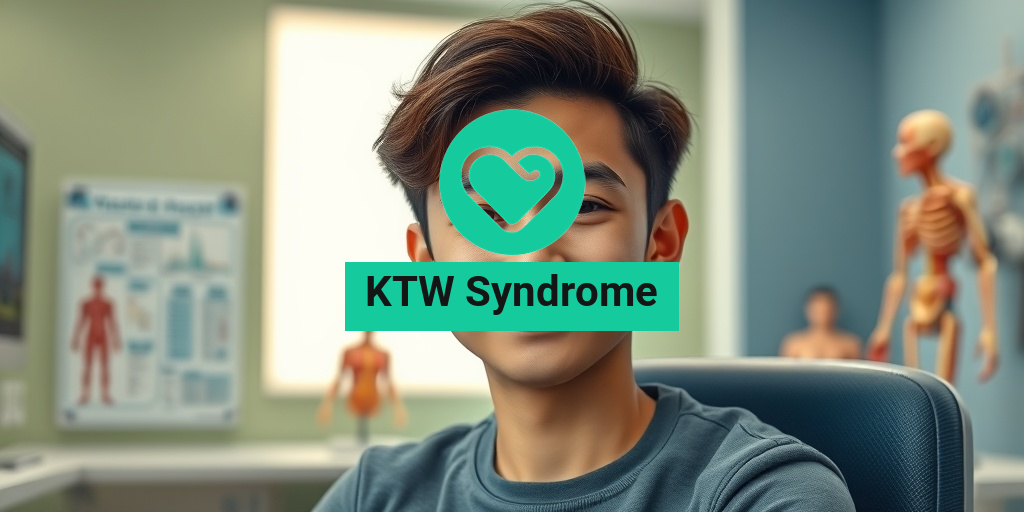What Is KTW Syndrome?
KTW Syndrome, also known as Kell Trenaunay Weber Syndrome, is a rare congenital disorder characterized by a combination of vascular malformations, limb overgrowth, and various skin abnormalities. This syndrome is part of a broader category of conditions known as vascular malformations, which can significantly impact an individual’s quality of life.
The name “KTW” is derived from the surnames of the three physicians who first described the condition: Kell, Trenaunay, and Weber. While the exact cause of KTW Syndrome remains unclear, it is believed to arise from genetic mutations that affect blood vessel development during embryonic growth. This condition is often diagnosed in childhood, but symptoms can vary widely among individuals.
Understanding the Genetic Basis
Research into the genetic underpinnings of KTW Syndrome is ongoing. Some studies suggest that mutations in specific genes related to vascular development may play a role. However, more research is needed to fully understand the genetic factors involved. If you suspect that you or a loved one may have KTW Syndrome, consulting with a healthcare professional or a geneticist can provide valuable insights.
KTW Syndrome Symptoms
The symptoms of KTW Syndrome can vary significantly from person to person, making it a complex condition to diagnose and manage. Here are some of the most common symptoms associated with KTW Syndrome:
- Limb Overgrowth: One of the hallmark features of KTW Syndrome is the disproportionate growth of one or more limbs. This can lead to significant differences in size and shape, which may require surgical intervention in severe cases.
- Vascular Malformations: Individuals with KTW Syndrome often experience abnormal blood vessel formations, which can manifest as varicose veins, hemangiomas, or other vascular lesions.
- Skin Abnormalities: Skin changes, such as hyperpigmentation or the presence of birthmarks, are common. These can vary in appearance and may require dermatological evaluation.
- Chronic Pain: Many individuals report chronic pain in affected limbs due to the strain of overgrowth and vascular issues.
- Functional Limitations: Depending on the severity of the symptoms, individuals may face challenges with mobility and daily activities.
Associated Conditions
KTW Syndrome can sometimes be associated with other conditions, such as Klippel-Trenaunay Syndrome (KTS), which shares similar features but has distinct characteristics. Understanding these associations is crucial for comprehensive management and treatment.
When to Seek Medical Advice
If you notice any of the symptoms mentioned above, it is essential to seek medical advice. Early diagnosis and intervention can significantly improve outcomes and quality of life. Healthcare providers may recommend imaging studies, such as radiology assessments, to evaluate vascular structures and plan appropriate treatment strategies.
For those looking for more information on KTW Syndrome and related conditions, resources like Yesil Health AI can provide evidence-based health answers and support.
Conclusion
KTW Syndrome is a complex and rare condition that requires a multidisciplinary approach for effective management. Understanding the symptoms and seeking timely medical advice can help individuals navigate the challenges associated with this syndrome. If you or someone you know is affected by KTW Syndrome, remember that you are not alone, and there are resources available to support you on this journey. 🌟

KTW Syndrome Causes
KTW Syndrome, a rare vascular disorder, is characterized by a combination of symptoms that can significantly impact an individual’s quality of life. Understanding the causes of KTW Syndrome is crucial for early diagnosis and effective management. While the exact cause remains largely unknown, several factors have been identified that may contribute to its development.
Genetic Factors
One of the primary suspected causes of KTW Syndrome is genetic predisposition. Research suggests that mutations in specific genes may play a role in the development of this syndrome. Although the exact genes involved are still under investigation, familial cases have been reported, indicating a potential hereditary component. If you have a family history of vascular disorders, it may be worth discussing with your healthcare provider.
Vascular Abnormalities
KTW Syndrome is often associated with various vascular abnormalities. These can include malformations of blood vessels, which may lead to the characteristic symptoms of the syndrome. The improper formation of veins and arteries can result in complications such as swelling, pain, and skin changes. Understanding these vascular issues is essential for both diagnosis and treatment.
Environmental Factors
While genetic factors are significant, environmental influences may also contribute to the onset of KTW Syndrome. Factors such as exposure to certain toxins or infections during pregnancy could potentially affect fetal development, leading to vascular malformations. However, more research is needed to establish a clear link between environmental factors and KTW Syndrome.
KTW Syndrome Risk Factors
Identifying risk factors for KTW Syndrome can aid in early detection and intervention. While the syndrome is rare, certain factors may increase the likelihood of developing this condition.
Family History
A strong family history of vascular disorders can be a significant risk factor for KTW Syndrome. If relatives have been diagnosed with similar conditions, it may indicate a genetic predisposition. Genetic counseling can provide valuable insights for families concerned about hereditary risks.
Age and Gender
KTW Syndrome can affect individuals of any age, but it is often diagnosed in childhood or early adulthood. Additionally, some studies suggest that the syndrome may be more prevalent in females than males, although the reasons for this disparity are not fully understood.
Associated Conditions
Individuals with other vascular malformations or syndromes may be at a higher risk for developing KTW Syndrome. Conditions such as Klippel-Trenaunay Syndrome, which involves similar vascular abnormalities, can overlap with KTW Syndrome. Understanding these associations can help healthcare providers in making accurate diagnoses and treatment plans.
Pregnancy and Developmental Factors
Pregnancy complications, such as maternal infections or exposure to harmful substances, may increase the risk of KTW Syndrome in the developing fetus. Ensuring a healthy pregnancy through regular prenatal care can help mitigate some of these risks.
In conclusion, while the exact causes and risk factors for KTW Syndrome are still being explored, understanding these elements can empower individuals and families to seek timely medical advice and interventions. If you suspect you or a loved one may be affected by KTW Syndrome, consulting with a healthcare professional is essential for proper evaluation and management. 🩺

KTW Syndrome Diagnosis
Diagnosing KTW Syndrome can be a complex process due to its rarity and the variability of symptoms among individuals. This syndrome, characterized by a combination of symptoms including vascular malformations, limb overgrowth, and other anomalies, often requires a multidisciplinary approach for accurate diagnosis.
Clinical Evaluation
The first step in diagnosing KTW Syndrome typically involves a thorough clinical evaluation. Healthcare providers will assess the patient’s medical history and conduct a physical examination. Key indicators that may lead to a suspicion of KTW Syndrome include:
- Vascular Malformations: These can manifest as varicose veins, port-wine stains, or other abnormal blood vessel formations.
- Limb Overgrowth: Patients may exhibit disproportionate growth of limbs, which is a hallmark of the syndrome.
- Other Anomalies: Additional features may include skeletal abnormalities or other organ system involvement.
Imaging Studies
To confirm a diagnosis of KTW Syndrome, imaging studies play a crucial role. Radiology techniques such as ultrasound, MRI, or CT scans can help visualize vascular malformations and assess the extent of limb overgrowth. These imaging modalities provide essential information that aids in differentiating KTW Syndrome from other similar conditions, such as Klippel-Trenaunay Syndrome.
Genetic Testing
In some cases, genetic testing may be recommended to identify specific mutations associated with KTW Syndrome. While not all patients will have identifiable genetic markers, this testing can provide valuable insights into the condition and help guide treatment options.
KTW Syndrome Treatment Options
Treatment for KTW Syndrome is highly individualized and depends on the severity of symptoms and the specific needs of the patient. The primary goal of treatment is to manage symptoms, improve quality of life, and address any complications that may arise.
Symptomatic Management
For many patients, symptomatic management is the first line of treatment. This may include:
- Pain Management: Medications such as non-steroidal anti-inflammatory drugs (NSAIDs) may be prescribed to alleviate pain associated with vascular malformations or limb overgrowth.
- Compression Therapy: Wearing compression garments can help manage swelling and improve circulation in affected limbs.
- Physical Therapy: Engaging in physical therapy can enhance mobility and strength, particularly for those with limb overgrowth.
Surgical Interventions
In cases where symptoms are severe or complications arise, surgical interventions may be necessary. Options include:
- Vascular Surgery: Procedures to correct vascular malformations or improve blood flow may be indicated.
- Orthopedic Surgery: Surgical options may be considered to address limb overgrowth or skeletal abnormalities.
- Cosmetic Surgery: For some patients, cosmetic procedures may be sought to improve the appearance of affected areas.
Multidisciplinary Care
Given the complexity of KTW Syndrome, a multidisciplinary approach is often beneficial. This may involve collaboration among various specialists, including:
- Geneticists: To provide insights into the genetic aspects of the syndrome.
- Vascular Surgeons: For management of vascular complications.
- Physical Therapists: To assist with rehabilitation and mobility.
Overall, the treatment plan for KTW Syndrome should be tailored to the individual, taking into account their unique symptoms and challenges. Regular follow-up with healthcare providers is essential to monitor progress and adjust treatment as needed. 🌟

Living with KTW Syndrome
KTW Syndrome, a rare genetic disorder, can significantly impact the lives of those affected. Understanding how to navigate daily challenges is crucial for individuals and families dealing with this condition. In this section, we will explore the various aspects of living with KTW Syndrome, including symptoms, management strategies, and emotional support.
Understanding the Symptoms
Individuals with KTW Syndrome may experience a range of symptoms that can vary in severity. Some of the most common symptoms include:
- Kidney abnormalities: These can lead to issues such as hypertension and renal dysfunction.
- Hearing loss: Many individuals may experience varying degrees of hearing impairment.
- Facial features: Distinctive facial characteristics may be present, which can affect self-esteem and social interactions.
- Growth issues: Some individuals may face challenges related to growth and development.
Recognizing these symptoms early can lead to timely interventions and better management of the condition. Regular check-ups with healthcare professionals are essential to monitor any changes and address complications as they arise.
Management Strategies
Living with KTW Syndrome requires a comprehensive approach to management. Here are some effective strategies:
- Regular medical care: Establishing a routine with healthcare providers, including nephrologists and audiologists, is vital for monitoring kidney function and hearing health.
- Healthy lifestyle choices: A balanced diet and regular exercise can help manage symptoms and improve overall well-being. Staying hydrated is particularly important for kidney health.
- Emotional support: Connecting with support groups or mental health professionals can provide a safe space to share experiences and cope with the emotional challenges of living with a chronic condition.
Building a Support Network
Having a strong support network is crucial for individuals with KTW Syndrome. Family, friends, and healthcare providers can play a significant role in providing emotional and practical support. Here are some ways to build and maintain a supportive environment:
- Educate loved ones: Sharing information about KTW Syndrome can help family and friends understand the condition better and offer appropriate support.
- Join support groups: Connecting with others who have similar experiences can foster a sense of community and provide valuable resources.
- Advocate for yourself: Being proactive in communicating your needs and concerns to healthcare providers can lead to better care and outcomes.
KTW Syndrome Research and Future Directions
Research into KTW Syndrome is ongoing, with scientists and medical professionals striving to uncover more about this rare condition. Understanding the genetic basis and potential treatment options is crucial for improving the quality of life for those affected.
Current Research Efforts
Researchers are focusing on several key areas to enhance our understanding of KTW Syndrome:
- Genetic studies: Identifying the specific genes involved in KTW Syndrome can help in understanding its inheritance patterns and potential risks for future generations.
- Clinical trials: New treatment options are being explored, including therapies aimed at managing symptoms and improving kidney function.
- Longitudinal studies: Tracking individuals over time can provide insights into the progression of the syndrome and the effectiveness of various management strategies.
Future Directions in Treatment
As research progresses, several promising avenues are emerging for the treatment of KTW Syndrome:
- Gene therapy: This innovative approach aims to correct the underlying genetic defects, potentially offering a long-term solution for those affected.
- Targeted therapies: Developing medications that specifically address the symptoms of KTW Syndrome could improve the quality of life for individuals.
- Personalized medicine: Tailoring treatment plans based on an individual’s unique genetic makeup may lead to more effective management strategies.
As we continue to learn more about KTW Syndrome, the hope is that advancements in research will lead to better treatments and improved outcomes for those living with this condition. 🌟

Frequently Asked Questions about KTW Syndrome
What is KTW Syndrome?
KTW Syndrome is a rare genetic disorder characterized by a combination of specific physical anomalies. It is often associated with various vascular and skeletal abnormalities, which can significantly impact an individual’s health and quality of life.
What are the symptoms of KTW Syndrome?
Individuals with KTW Syndrome may exhibit a range of symptoms, including:
- Vascular malformations
- Bone deformities
- Skin changes
- Possible neurological issues
How is KTW Syndrome diagnosed?
Diagnosis of KTW Syndrome typically involves a combination of clinical evaluation, imaging studies, and genetic testing. Radiological assessments can help identify the specific anomalies associated with the syndrome.
What treatments are available for KTW Syndrome?
While there is no cure for KTW Syndrome, treatment options focus on managing symptoms and complications. This may include:
- Physical therapy
- Surgical interventions for vascular or skeletal issues
- Regular monitoring and supportive care
Is KTW Syndrome hereditary?
The inheritance pattern of KTW Syndrome is not fully understood, but it is believed to have a genetic component. Consulting with a genetic counselor can provide insights into the risks for family members.
How rare is KTW Syndrome?
KTW Syndrome is considered a rare condition, with limited data on its prevalence. Ongoing research aims to better understand its occurrence and characteristics.
Where can I find support for KTW Syndrome?
Support groups and organizations dedicated to rare genetic disorders can provide valuable resources and community connections for individuals and families affected by KTW Syndrome.
Are there any ongoing research studies on KTW Syndrome?
Yes, researchers are actively studying KTW Syndrome to uncover more about its causes, effects, and potential treatments. Participating in clinical trials may be an option for some patients.




